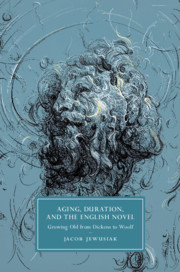Book contents
- Aging, Duration, and the English Novel
- Cambridge Studies in Nineteenth-Century
- Aging, Duration, and the English Novel
- Copyright page
- Dedication
- Contents
- Acknowledgments
- Abbreviations
- Introduction
- Chapter 1 Aging Theory
- Chapter 2 No Plots for Old Men
- Chapter 3 Life After the Marriage Plot
- Chapter 4 A Wrinkle in Time
- Chapter 5 The Technology Age
- Chapter 6 Gray Modernism
- Afterword
- Notes
- Bibliography
- Index
- Cambridge Studies in Nineteenth-Century
Chapter 2 - No Plots for Old Men
Published online by Cambridge University Press: 14 November 2019
- Aging, Duration, and the English Novel
- Cambridge Studies in Nineteenth-Century
- Aging, Duration, and the English Novel
- Copyright page
- Dedication
- Contents
- Acknowledgments
- Abbreviations
- Introduction
- Chapter 1 Aging Theory
- Chapter 2 No Plots for Old Men
- Chapter 3 Life After the Marriage Plot
- Chapter 4 A Wrinkle in Time
- Chapter 5 The Technology Age
- Chapter 6 Gray Modernism
- Afterword
- Notes
- Bibliography
- Index
- Cambridge Studies in Nineteenth-Century
Summary
“No Plots for Old Men” argues that aging raised a problem for Charles Dickens’s literary project: the novel’s difficulty of representing temporal continuity over long spans of time. For the old man, the meaningful plots of the nineteenth century—such as the bildungsroman or the marriage plot—are behind him. An object of little narrative interest from the perspective of these plots, the old man is continually activated in Dickens’s novels, setting up a competition between the natural death he staves off and the closure of the narrative in which he is enmeshed. By examining three of Dickens’s early novels, this chapter shows how old men are excluded from the youthful plot of development central to the progress of a modernizing society. No longer the subject of the plot and yet bound by ambition, the elderly male engages in a narrative compulsion that underlines the imaginative power of what has been left behind by both the realist novel and the modernity it represents. By doing so, the old man serves as the site through which Dickens addresses an impasse of the novel form, where its duration is marked by its inability to faithfully represent the texture of passing time.
- Type
- Chapter
- Information
- Aging, Duration, and the English NovelGrowing Old from Dickens to Woolf, pp. 47 - 69Publisher: Cambridge University PressPrint publication year: 2019

